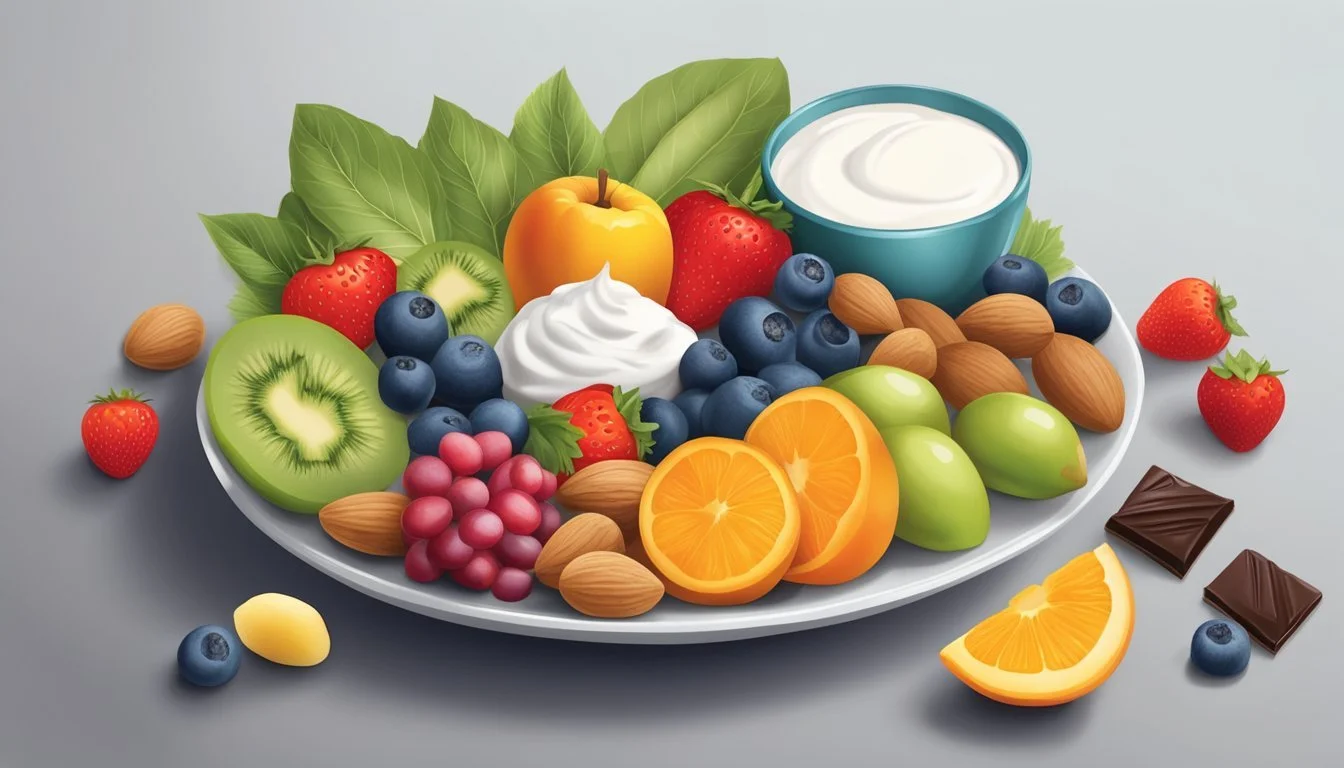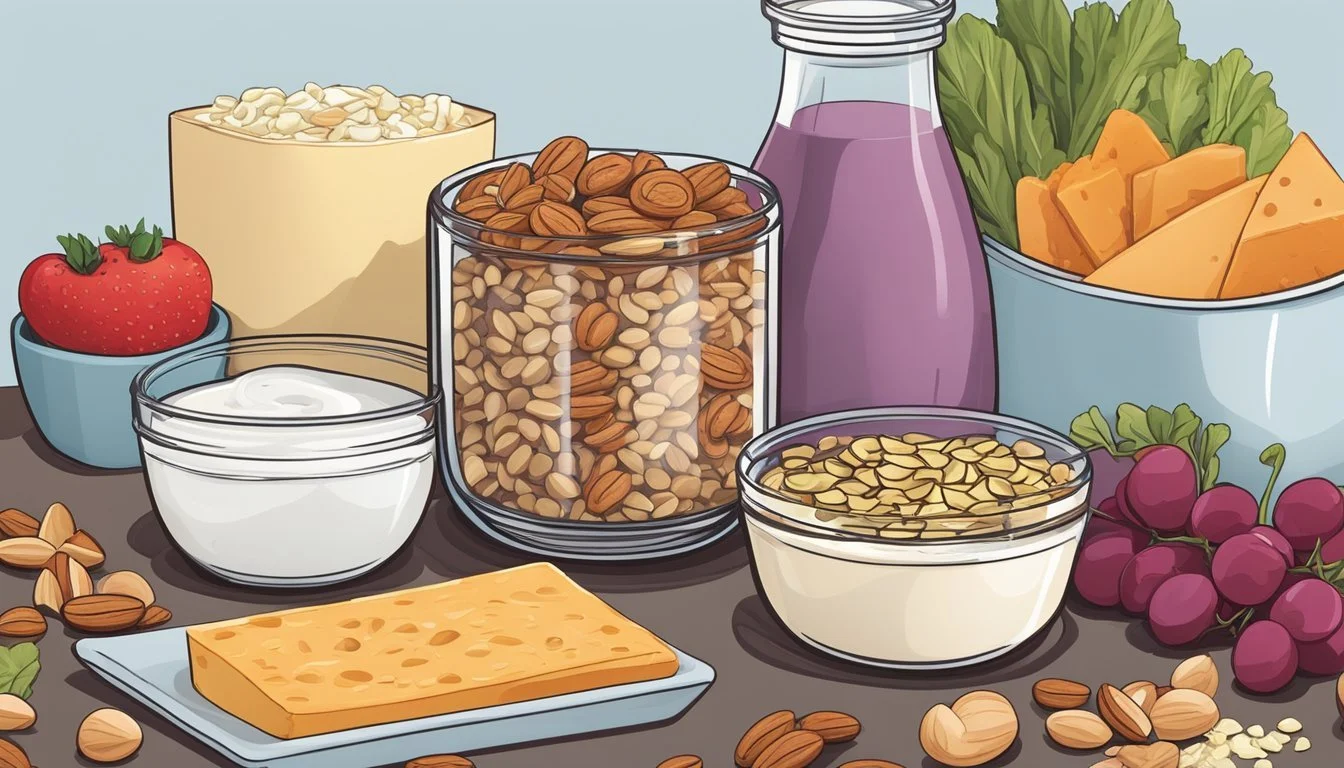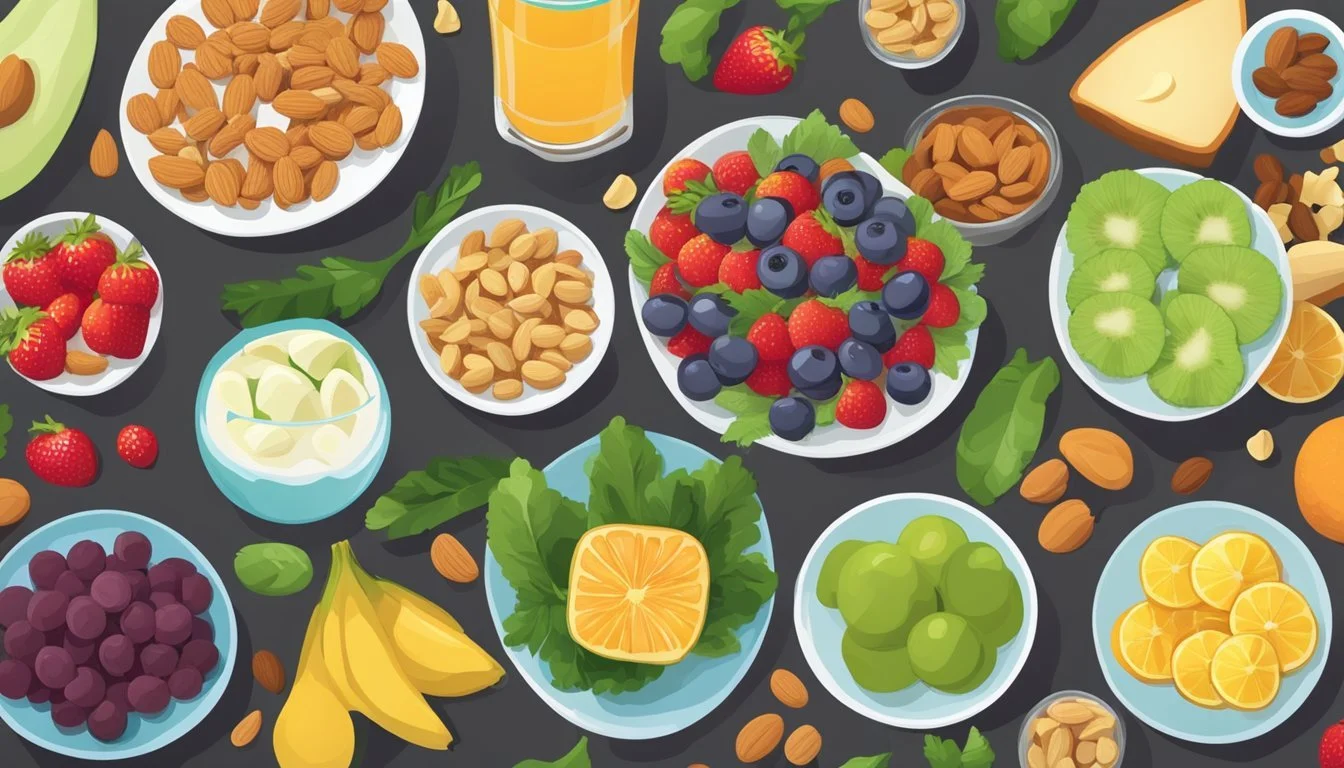Delicious Diabetes-Friendly Snacks for Steady Blood Sugar
Living with diabetes doesn't mean sacrificing tasty snacks. Diabetes-friendly snacks can be both delicious and nutritious, helping to manage blood sugar levels while satisfying cravings. Smart snack choices for people with diabetes include options high in protein, fiber, and healthy fats, which can help regulate glucose levels and provide sustained energy throughout the day.
These snacks come in a variety of flavors and textures, from crunchy roasted chickpeas to creamy Greek yogurt bark. Hard-boiled eggs, for example, offer a protein-packed option that's easy to prepare and portable. Peanut butter energy balls combine wholesome ingredients for a sweet treat that won't spike blood sugar.
When selecting snacks, portion control remains key. Measuring tools can help ensure appropriate serving sizes. By incorporating nutrient-dense foods like vegetables, fruits, and whole grains into snack time, individuals with diabetes can maintain stable blood sugar levels while enjoying flavorful bites between meals.
Understanding Diabetes and Nutrition
Proper nutrition plays a crucial role in managing diabetes. A balanced diet helps control blood sugar levels and supports overall health for individuals with this condition.
The Role of Diet in Blood Sugar Control
Dietary choices significantly impact blood glucose levels in people with diabetes. Carbohydrates have the most direct effect on blood sugar, as they're broken down into glucose during digestion. Fiber, found in many plant-based foods, slows digestion and helps stabilize blood sugar.
Protein and fat have minimal immediate effects on blood glucose but can influence long-term blood sugar control. Consistent meal timing and portion control are essential for maintaining steady blood sugar levels throughout the day.
Regular monitoring of blood glucose and adjusting food intake accordingly helps individuals with diabetes achieve better control.
Macronutrients and Diabetes
Carbohydrates, proteins, and fats each play unique roles in diabetes management:
Carbohydrates: Primary source of energy, directly affects blood sugar
Protein: Supports muscle health, minimal impact on blood glucose
Fat: Provides energy, slows digestion of other nutrients
A balanced intake of these macronutrients is key. The American Diabetes Association recommends:
Macronutrient Recommended Intake Carbohydrates 45-60% of calories Protein 15-20% of calories Fat 20-35% of calories
Focusing on complex carbohydrates, lean proteins, and healthy fats can help maintain stable blood sugar levels.
Glycemic Index and Glycemic Load
The glycemic index (GI) measures how quickly a food raises blood sugar levels. Foods are ranked on a scale of 0 to 100:
Low GI: 55 or less
Medium GI: 56-69
High GI: 70 or above
Glycemic load (GL) considers both the GI and the amount of carbohydrates in a serving. It provides a more accurate picture of a food's impact on blood sugar.
Choosing low GI and GL foods can help individuals with diabetes manage their blood glucose more effectively. Examples include non-starchy vegetables, whole grains, and legumes.
Balancing high GI foods with protein or fat can also help moderate blood sugar spikes. This approach allows for more flexibility in meal planning while maintaining good blood glucose control.
Criteria for Diabetes-Friendly Snacks
Selecting appropriate snacks is crucial for managing blood sugar levels in people with diabetes. Key factors include balancing macronutrients, limiting saturated fats and sodium, and controlling portion sizes and calorie intake.
Balancing Macronutrients
A diabetes-friendly snack should contain a mix of carbohydrates, protein, and healthy fats. Carbohydrates directly affect blood sugar, so choosing complex carbs is essential. Aim for 15-20 grams of carbs per snack.
Protein helps stabilize blood sugar and provides satiety. Include 5-10 grams of protein in each snack. Good sources are eggs, Greek yogurt, and nuts.
Healthy fats slow digestion and improve nutrient absorption. Incorporate small amounts of unsaturated fats from sources like avocados or olive oil.
Fiber-rich foods are beneficial as they slow carbohydrate absorption. Choose whole grains, fruits, and vegetables for their fiber content.
Choosing Snacks Low in Saturated Fats and Sodium
Saturated fats can increase cholesterol levels and cardiovascular risk. Opt for snacks with less than 2 grams of saturated fat per serving.
Limit processed foods high in sodium, as excessive intake can raise blood pressure. Look for snacks with less than 140 mg of sodium per serving.
Choose fresh fruits and vegetables, which are naturally low in both saturated fats and sodium. When selecting packaged snacks, read nutrition labels carefully.
Unsalted nuts, seeds, and air-popped popcorn are good low-sodium options. Replace high-fat dairy with low-fat or fat-free alternatives.
Understanding Portion Sizes and Calories
Controlling portion sizes is vital for managing blood sugar and maintaining a healthy weight. Use measuring tools or visual cues to ensure accurate portions.
A typical diabetes-friendly snack should contain 100-200 calories. This range helps maintain energy levels without causing significant blood sugar spikes.
Pre-portion snacks into small containers to avoid overeating. Single-serving packages can be helpful for portion control.
Be mindful of calorie-dense foods like nuts and cheese. While nutritious, they should be consumed in moderation due to their high calorie content.
The Benefits of Fiber-Rich Snacks
Fiber-rich snacks offer numerous advantages for people with diabetes. They help regulate blood sugar levels and provide lasting fullness between meals.
Fiber's Role in Digestion and Heart Health
Fiber plays a crucial role in promoting digestive health. It adds bulk to stools, preventing constipation and supporting regular bowel movements. Soluble fiber forms a gel-like substance in the digestive tract, slowing down digestion and helping to stabilize blood sugar levels.
Heart health also benefits from a high-fiber diet. Soluble fiber can help lower cholesterol levels by binding to cholesterol particles and removing them from the body. This process may reduce the risk of heart disease, a common concern for people with diabetes.
Fiber-rich foods often contain valuable nutrients like vitamins, minerals, and antioxidants. These compounds contribute to overall health and may help manage diabetes-related complications.
High-Fiber Snack Ideas
Legumes, particularly chickpeas, make excellent high-fiber snacks. Roasted chickpeas offer a crunchy, satisfying texture and can be seasoned with various spices for added flavor. A quarter-cup serving provides about 5 grams of fiber.
Vegetables are another fiber-rich option. Raw carrot sticks, celery, or bell pepper slices paired with hummus create a nutritious snack. These choices are low in calories and high in fiber, making them ideal for blood sugar management.
Fruits like apples, pears, and berries are packed with fiber and natural sweetness. Combining fruit with a small handful of nuts adds healthy fats and protein, creating a balanced snack that won't spike blood sugar levels.
Whole grain options such as air-popped popcorn or whole grain crackers provide fiber along with complex carbohydrates. These snacks offer sustained energy and help maintain steady blood glucose levels.
Protein-Packed Snacks for Sustained Energy
Protein-rich snacks play a crucial role in managing blood sugar levels and providing lasting energy for people with diabetes. These nutritious options offer satiety and help maintain stable glucose throughout the day.
Benefits of Protein in Diabetes Management
Protein is essential for individuals with diabetes. It slows digestion, reducing blood sugar spikes after meals. This nutrient also promotes feelings of fullness, which can aid in weight management. Protein supports muscle maintenance and repair, crucial for overall health.
Consuming protein-rich snacks between meals helps stabilize blood glucose levels. This can prevent sudden drops or rises in sugar, reducing the risk of hypoglycemia or hyperglycemia. Protein also has a minimal impact on blood sugar compared to carbohydrates.
For those using insulin, protein intake can help prevent low blood sugar during physical activity or between meals. It provides a steady source of energy without causing rapid changes in glucose levels.
Examples of High-Protein Snacks
Several tasty and convenient high-protein snacks are suitable for people with diabetes. Greek yogurt is an excellent choice, offering about 15-20 grams of protein per serving. It can be paired with berries or a small amount of nuts for added flavor and nutrients.
Hard-boiled eggs are portable and protein-packed. One large egg contains about 6 grams of protein and minimal carbohydrates. They make an easy grab-and-go snack.
Edamame is a plant-based option rich in protein and fiber. A half-cup serving provides around 8 grams of protein. It's a satisfying snack that can be enjoyed hot or cold.
Tuna is another protein powerhouse. A small can of tuna contains about 20 grams of protein. It can be eaten on its own or mixed with vegetables for a quick, nutritious snack.
Cottage cheese is high in protein and low in carbohydrates. A half-cup serving offers about 14 grams of protein. It pairs well with fresh fruit or can be enjoyed plain.
Nuts like almonds or walnuts provide protein, healthy fats, and fiber. A small handful (about 1 ounce) can offer 5-6 grams of protein. They're convenient and don't require refrigeration.
Healthy Fats and Diabetes
Incorporating healthy fats into diabetes-friendly snacks can help manage blood sugar levels and provide essential nutrients. These fats offer numerous benefits for people with diabetes when consumed in moderation.
Monounsaturated and Polyunsaturated Fats
Monounsaturated and polyunsaturated fats are considered heart-healthy options for individuals with diabetes. These fats can help improve insulin sensitivity and reduce inflammation in the body.
Monounsaturated fats are found in foods like avocados, olive oil, and nuts. They can help lower bad cholesterol levels while maintaining good cholesterol.
Polyunsaturated fats, including omega-3 fatty acids, are present in fatty fish, walnuts, and flaxseeds. These fats support brain function and may help reduce the risk of heart disease.
Replacing saturated and trans fats with these healthier options can contribute to better overall health for people with diabetes.
Snack Ideas with Healthy Fats
Incorporating healthy fats into diabetes-friendly snacks is easy and delicious. Here are some nutritious options:
A quarter of an avocado spread on whole-grain toast
A small handful of unsalted almonds or walnuts
Celery sticks with natural peanut butter
Greek yogurt topped with chia seeds
These snacks combine healthy fats with fiber and protein, helping to stabilize blood sugar levels and provide sustained energy.
Homemade trail mix with nuts, seeds, and a small amount of dried fruit can be a convenient on-the-go option.
For a savory snack, try roasted chickpeas tossed in olive oil and spices. This provides a good balance of healthy fats, protein, and fiber.
Smart Snacking and Blood Sugar Levels
Choosing the right snacks can help maintain stable blood sugar levels for people with diabetes. Strategic snacking focuses on nutrient-rich foods that provide sustained energy without causing rapid spikes.
Preventing Blood Sugar Spikes with Snacks
Selecting snacks with complex carbohydrates, fiber, and protein helps prevent sharp blood sugar rises. Whole grains, fruits, and vegetables are excellent choices. A small apple with a tablespoon of almond butter combines fiber and healthy fats.
Portion control is crucial. Even healthy snacks can cause spikes if overeaten. Measure servings to avoid excess calories and carbohydrates.
Timing matters too. Eating small, frequent snacks throughout the day can help maintain steady blood sugar levels. This approach prevents long gaps between meals that might lead to overeating.
Snacks for Keeping Blood Sugar Stable
Nuts like almonds and pistachios are ideal for blood sugar stability. They're rich in protein, healthy fats, and fiber. A quarter-cup serving provides satiety without significantly impacting blood sugar.
Air-popped popcorn is a satisfying, low-calorie option. Three cups contain only 15 grams of carbohydrates and provide filling fiber.
Greek yogurt with berries offers protein and antioxidants. The protein slows digestion, while berries add natural sweetness without excessive sugar.
Hard-boiled eggs make excellent snacks. They're protein-rich and have no carbohydrates, helping maintain stable blood sugar levels between meals.
Delicious Low-Sugar Snack Options
Diabetics can enjoy tasty treats without compromising blood sugar control. Many options provide satisfying sweetness while keeping added sugars low.
Natural Sweetness Without Added Sugars
Whole fruits offer natural sweetness and fiber. Apples make an excellent on-the-go snack, providing a satisfying crunch and steady energy release. Berries like blueberries are packed with antioxidants and have a lower glycemic impact than many other fruits.
Roasted chickpeas seasoned with cinnamon or savory spices deliver protein and fiber. They offer a crunchy alternative to sugary snacks.
Greek yogurt topped with a sprinkle of nuts provides creamy texture and protein. The natural tang reduces the need for added sweeteners.
Fruit-Based Snacks and Artificial Sweeteners
Fruit leather made from pureed berries or apples without added sugar can satisfy sweet cravings. Look for brands with no added sweeteners or make your own at home.
Dark chocolate with at least 70% cocoa content contains less sugar than milk chocolate. It provides antioxidants and a rich flavor that can be savored in small portions.
Sugar-free gelatin or pudding made with artificial sweeteners offer a low-carb dessert option. These can be topped with fresh berries for added nutrition and natural sweetness.
Creative Snack Recipes and Ideas
Diabetes-friendly snacks can be both delicious and nutritious. These recipes and ideas offer tasty options that help manage blood sugar levels while satisfying cravings.
Homemade Snack Preparations
Kale chips are a crunchy, low-carb alternative to potato chips. Toss kale leaves with olive oil and seasonings, then bake until crisp.
Roasted chickpeas provide a protein-packed snack. Season with garlic powder, paprika, or curry spices before roasting for added flavor.
Peanut butter energy balls combine nut butter, oats, and seeds for a portable treat. Roll the mixture into small balls and refrigerate for easy grab-and-go snacks.
Homemade hummus offers endless flavor possibilities. Try avocado hummus for healthy fats or garlic hummus for a classic taste. Serve with vegetable sticks for dipping.
Quick and Portable Snack Solutions
Pre-portioned nut butter packets paired with apple slices create a balanced snack. Look for single-serve options without added sugars.
Seed mixes offer a crunchy, nutrient-dense option. Combine pumpkin seeds, sunflower seeds, and unsweetened coconut flakes for variety.
Hard-boiled eggs provide protein and can be prepared in advance. Sprinkle with salt and pepper or a favorite seasoning blend for extra flavor.
Greek yogurt topped with berries and a sprinkle of nuts offers a creamy, sweet-and-tart snack. Choose plain, unsweetened yogurt to control sugar intake.
The Impact of Snacking on Overall Health
Snacking habits play a crucial role in managing diabetes and overall health. Thoughtful snack choices can aid weight control, reduce inflammation, and help maintain healthy cholesterol levels.
Snacking for Weight Management
Smart snacking can support weight management efforts. Choosing nutrient-dense snacks helps control appetite and promotes feelings of fullness between meals. Protein-rich options like hard-boiled eggs or Greek yogurt can curb hunger and prevent overeating. Fiber-filled snacks such as vegetables with hummus or a small handful of nuts provide lasting satiety.
Portion control is key. Using measuring tools ensures appropriate serving sizes. Small, frequent snacks can stabilize blood sugar levels and boost metabolism. This approach may prevent excessive calorie intake at main meals.
Snacks that combine protein, healthy fats, and complex carbohydrates offer balanced nutrition. Examples include apple slices with almond butter or whole-grain crackers with cheese. These combinations provide sustained energy and help maintain steady blood glucose levels.
Snacks and Their Role in Inflammation and Cholesterol
The right snacks can combat inflammation and support healthy cholesterol levels. Foods rich in omega-3 fatty acids, like walnuts or chia seeds, possess anti-inflammatory properties. These can help reduce systemic inflammation associated with diabetes.
Antioxidant-packed snacks such as berries or dark chocolate (in moderation) fight oxidative stress. This may lower inflammation markers in the body. Choosing whole foods over processed snacks reduces intake of pro-inflammatory ingredients like refined sugars and unhealthy fats.
Snacks high in soluble fiber, including oats or lentils, can help lower LDL cholesterol. Plant-based proteins found in edamame or roasted chickpeas support heart health. Limiting saturated fats and opting for sources of unsaturated fats like avocado or olive oil in snacks can improve cholesterol profiles.
Additional Considerations for Diabetes-Friendly Snacking
Successful diabetes management involves more than just choosing the right snacks. It requires understanding nutrition labels and working closely with healthcare professionals to develop personalized eating plans.
Understanding Food Labels and Nutrition Information
Reading food labels is crucial for people with diabetes. Labels provide essential information about carbohydrates, fiber, protein, and other nutrients. The total carbohydrate content is particularly important, as it directly affects blood sugar levels.
Serving sizes should be carefully noted, as they impact the actual nutrient intake. Checking for added sugars and unhealthy fats is also vital. Many seemingly healthy snacks can contain hidden sugars or unhealthy fats that may negatively affect insulin levels.
Fiber content is another key factor to consider. High-fiber snacks can help slow down carbohydrate absorption, leading to more stable blood sugar levels. Nutrients like magnesium, potassium, vitamin C, and vitamin E are beneficial for overall health and diabetes management.
Consulting with Healthcare Professionals
A registered dietitian or diabetes educator can provide invaluable guidance in creating a personalized snacking plan. These professionals can help individuals understand how different foods affect their blood sugar and hemoglobin A1C levels.
They can also offer advice on portion control to prevent overeating and maintain stable blood sugar levels. Healthcare professionals can recommend specific vitamins and minerals that may be beneficial for diabetes management.
Regular check-ups with a healthcare team allow for adjustments to the snacking plan based on individual needs and changes in health status. This collaborative approach ensures that the snacking strategy remains effective and aligned with overall diabetes management goals.






